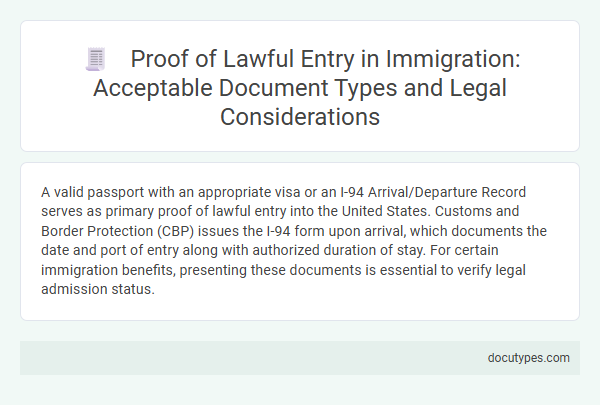A valid passport with an appropriate visa or an I-94 Arrival/Departure Record serves as primary proof of lawful entry into the United States. Customs and Border Protection (CBP) issues the I-94 form upon arrival, which documents the date and port of entry along with authorized duration of stay. For certain immigration benefits, presenting these documents is essential to verify legal admission status.
Understanding Lawful Entry in Immigration
Proof of lawful entry is essential in immigration to demonstrate that an individual has legally entered a country. This documentation verifies compliance with immigration laws and eligibility for benefits or status adjustments.
Common documents used as proof include a valid visa, a stamped passport page from the port of entry, or an Form I-94 Arrival/Departure Record. Understanding these documents ensures proper submission during immigration processes.
Importance of Proof of Lawful Entry
Proof of lawful entry is typically demonstrated through documents such as an I-94 Arrival/Departure Record, visa stamps in your passport, or an admission notice from U.S. Customs and Border Protection. These documents confirm your legal entry into the country, which is crucial for processing immigration benefits and employment eligibility.
Providing valid proof of lawful entry ensures compliance with immigration laws and safeguards your rights during application processes. Your ability to access work, education, and legal protections depends on presenting this essential documentation accurately.
Commonly Accepted Documents for Lawful Entry
Proof of lawful entry is essential for immigration processes to verify an individual's legal entry into a country. Commonly accepted documents serve as evidence to establish this legal status.
- Passport with Valid Visa - A passport containing a valid visa stamp or electronic travel authorization confirms lawful entry for temporary or permanent residence.
- I-94 Arrival/Departure Record - This form, issued by U.S. Customs and Border Protection, details the date and port of entry for noncitizens entering the United States.
- Entry Stamp from Border Officials - An official stamp on a travel document indicates lawful admission at a port of entry by immigration authorities.
Valid Passports and Entry Stamps
Proof of lawful entry into a country is essential for immigration procedures. Valid passports and entry stamps serve as primary documentation verifying legal admission.
- Valid Passport - A government-issued travel document confirming identity and nationality.
- Entry Stamp - An official mark placed by immigration authorities indicating date and port of entry.
- Combined Evidence - Together, passports and entry stamps establish lawful and authorized entry status.
Providing clear and authentic documentation streamlines the immigration process and confirms compliance with legal entry requirements.
Border Crossing Cards and Admission Records
Proof of lawful entry into the United States requires specific documents such as Border Crossing Cards (BCC) and Admission Records issued by U.S. Customs and Border Protection. These documents verify the individual's authorized entry and immigration status.
Border Crossing Cards serve as both a visa and a border crossing document for Mexican citizens entering the U.S. for short visits. Admission Records, often Form I-94, provide official evidence of arrival and lawful admission for various visa holders. Maintaining accurate and current documentation is essential for all non-citizens to demonstrate legal entry and lawful presence.
Electronic I-94 Forms and Paper I-94 Cards
What type of document is required for proof of lawful entry into the United States?
The primary documents used to prove lawful entry are the Electronic I-94 forms and the paper I-94 cards. The Electronic I-94 is issued when entering air or sea ports, while paper I-94 cards are provided in certain land border crossings.
Immigrant and Nonimmigrant Visa Documentation
Proof of lawful entry into the United States requires specific documentation depending on visa status. Immigrants must present Form I-551, Permanent Resident Card, or Form I-94 with an immigrant visa stamp. Nonimmigrants provide Form I-94 Arrival/Departure Record, which indicates authorized admission under a valid nonimmigrant visa category.
Special Entry Permits and Parole Evidence
| Document Type | Description | Purpose |
|---|---|---|
| Special Entry Permits | Official authorizations granted by immigration authorities allowing entry into a country under specific conditions. | Used to demonstrate lawful entry when standard visas or entry stamps are not applicable. |
| Parole Evidence | Documentation or affidavits used to support claims of lawful entry when no formal entry record exists. | Serves as supplementary proof in immigration processes to establish lawful presence. |
Your ability to prove lawful entry may depend on submitting either Special Entry Permits or Parole Evidence, based on your specific immigration situation.
Legal Challenges and Document Verification
Proof of lawful entry is a critical element in immigration processes, requiring precise documentation to avoid legal challenges. Proper document verification ensures the authenticity of entry records and supports compliance with immigration laws.
- Form I-94 Arrival/Departure Record - This document serves as official proof of lawful entry for most non-citizens entering the United States.
- Visa Stamps and Approval Notices - These indicate the type of entry authorization granted and are essential for verifying the legality of initial entry.
- Legal Challenges in Document Verification - Discrepancies or fraudulent documents can lead to delays, denials, or removal proceedings in immigration cases.
What Type of Document Is Required for Proof of Lawful Entry? Infographic

